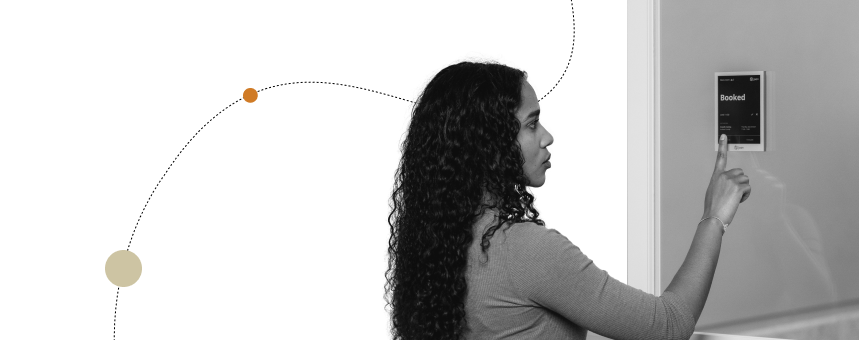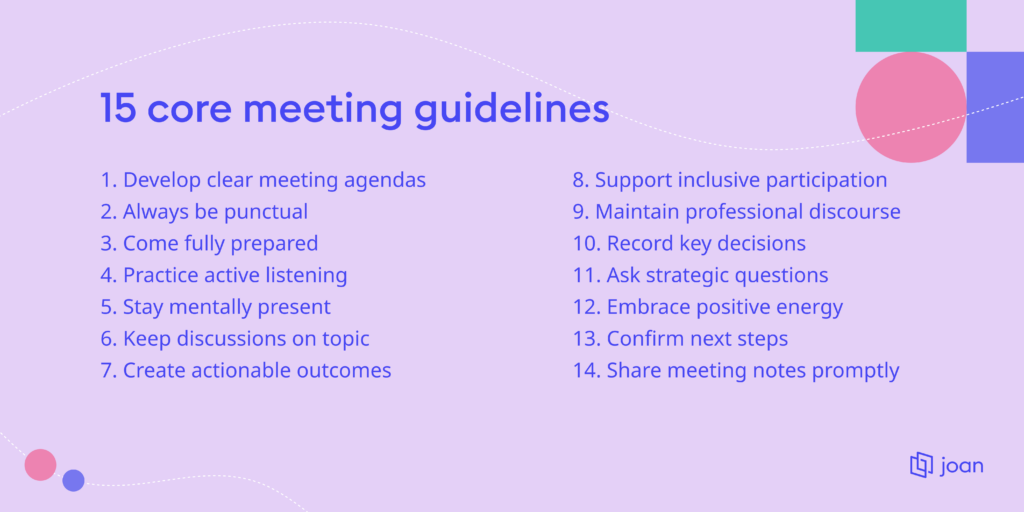



Poor meeting practices are a common workplace challenge. Whether it’s discussions that go off track, unclear next steps, or difficulty keeping participants engaged, these issues impact productivity across organizations. Meeting guidelines offer a practical solution by providing structure that helps teams stay focused and productive.
When teams implement consistent meeting guidelines, they create more effective work sessions where decisions get made and time is well spent. These guidelines serve as a framework that promotes participation, clarifies expectations, and helps achieve meeting objectives efficiently.
Ready to run meetings that actually get things done?
Before diving into our field-tested guidelines that work for any team size or industry, let’s understand what meeting guidelines really are.
Meeting guidelines are practical rules that transform unfocused gatherings into productive work sessions. They provide just enough structure to keep meetings focused while leaving room for creativity and open discussion. When everyone follows these guidelines, meetings transform from time-wasters into productive sessions where each voice matters and real work gets done.

Create and distribute detailed agendas that outline specific topics, time allocations, and expected outcomes. Include key discussion points, required decisions, and pre-reading materials. A strong agenda acts as your meeting’s roadmap, guiding productive discussions and preventing aimless conversations.
Start and end meetings exactly on time, regardless of who’s missing. This respects everyone’s time and sets a professional standard. For recurring meetings, track and share attendance patterns to reinforce the importance of punctuality. Remember: waiting for latecomers only rewards delayed arrivals.
Review all materials before the meeting. Prepare your thoughts, questions, and potential solutions. Bring necessary data and documents to support your points. This preparation ensures meaningful contributions and speeds up decision-making processes.
Focus entirely on the current speaker. Take notes, ask clarifying questions, and build on others’ ideas. Avoid interrupting or planning your response while others speak. Active listening leads to better understanding and more innovative solutions.
Put away phones, close unnecessary browser tabs, and focus solely on the meeting. If you’re remote, turn on your camera and maintain eye contact. Your full attention shows respect and leads to more efficient discussions.
Follow the agenda rigorously. When conversations drift, gently but firmly bring focus back to the current topic. Use a “parking lot” list for important but off-topic items that deserve separate discussion time.
Document specific action items during the meeting. Each action needs an owner, deadline, and clear success criteria. Avoid vague commitments – make every action item specific and measurable.

Create space for everyone to contribute. Use round-robin techniques for important decisions. Call on quieter team members thoughtfully. Remember: diverse perspectives lead to better outcomes.
Focus criticism on ideas, not individuals. Frame challenges constructively and offer solutions. Use “yes, and” instead of “but” to build on others’ contributions. Keep emotions professional and discussions productive.
Capture all decisions, including context and rationale. Note dissenting views and mitigation plans. Clear decision records prevent future confusion and help with accountability.
Time your questions for maximum impact. Focus on clarifying understanding and pushing discussions forward. Save detailed technical questions for offline discussions when appropriate.
Maintain an optimistic, solution-focused attitude. Celebrate progress and acknowledge good ideas. Your energy influences the entire group’s productivity and creativity.
End every meeting by reviewing action items, owners, and deadlines. Ensure everyone understands their responsibilities. Schedule follow-up meetings if needed.
Distribute detailed notes within 24 hours. Include decisions, action items, and key discussion points. Make notes accessible to all relevant team members, even those who couldn’t attend.
Regularly assess meeting quality using simple metrics like decision completion rates and participant engagement. Gather feedback and adjust your approach based on team input.
Success with meeting guidelines starts with a strategic, step-by-step approach. Here’s how to get started:
Want to learn how meeting room technology can support these guidelines?
Book a call with our workplace experience specialists and discover how to make your meetings work harder.